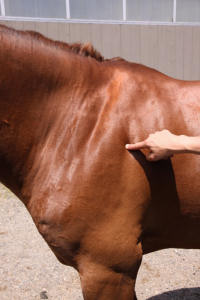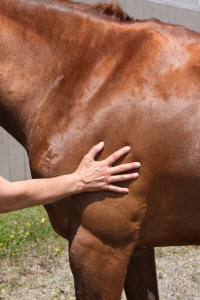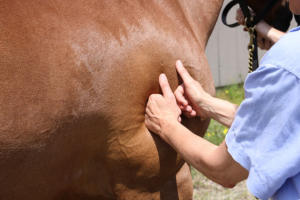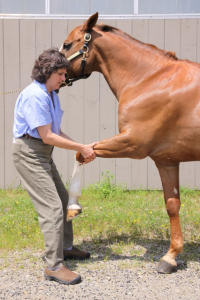|
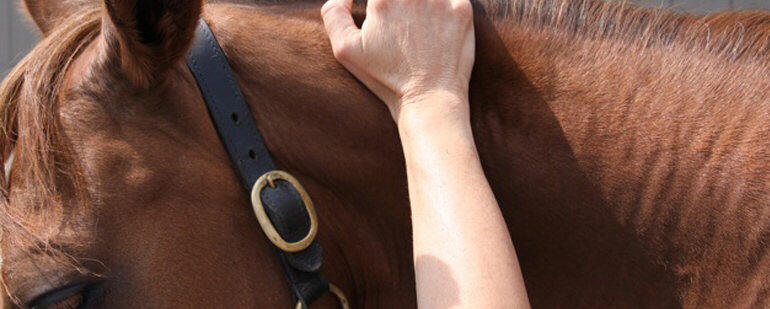 |
Presenting Problem: Hanging a front leg while jumping; appears short in front leg at extended trot. Problem: An event rider called because her horse had been placing in the top 5 all year until her last competition when the horse knocked three rails in show jumping and scored poorly in the lengthenings and extended trot work in dressage.
Muscle tightness effects the release process
of the muscle. Muscles appear in pairs of opposites. When one
contracts or shortens, the other must lengthen or release to allow
for a motion to occur. I had to think about what muscle was not
releasing to allow the horse to bring the leg forward and into
shoulder extension. Since the triceps muscle brings the leg back
toward the tail, I immediately assumed it may be the triceps muscle
responsible for the problems because, the triceps must be loose in
order to release and allow the leg to go forward. The horse was not
lame.
I palpated the triceps which is located on the shoulder. I determined the triceps was very tight and found a distinct spasm present where the triceps was anchored to the bone. The muscle belly felt hard and not pliable to my hand when I palpated. The horse also swished his tail and flinched when I palpated the triceps, indicating he was uncomfortable. Mechanics and Wilson Meagher Method of Sportsmassage: The triceps basically flexes the shoulder resulting in the front leg moving back toward the tail. It also extends the elbow as when a horse is standing. In order for the leg and shoulder to move forward toward the head , the triceps must let go or release. As stated earlier, when a muscle is tight, it effects the release process or lengthening of the muscle in order to let go and allow for the opposite motion to occur. Thus, I found the right triceps so tight that it was limiting the right leg from moving forward. Movements such as lengthenings or jumping clear over rails are effected when the triceps is tight, compromising forward shoulder and leg motion.
If you are unsure of how to work on the entire horse using compressions, please check out my DVD: A Course in Equine Sportsmassage. After the treatment using the Wilson Meagher Method of Sportsmassage, I had the rider jog the horse in hand to be certain the horse was sound. The horse was sound and no longer short in the right front! Follow Up: After my sportsmassage treatment, I made two recommendations. Exercise and passive stretching. Exercise should become part of the treatment. The exercise prepares the horse to be used, and further lengthens and stretches all of the major muscles. I recommend the canter as the best exercise to maximize the stretching. I also suggested she use passive stretching after applying the three sportsmassage techniques. I recommended she pick up the front leg at a ninety degree angle and gently ask the horse to bring the leg and shoulder forward. Do this two times following the sportsmassage. Result: The following day my client reported the horse felt great. He was jumping evenly in front and was even at the trot. She was ready for her next competition with confidence. The horse was relieved too! |
 |


